Pasture-raised may be profitable — but is it the proper paradigm for poultry?
Ecological agriculture emphasizes the importance of letting animals exert the essence of their animal-ness — putting animals in their natural environments and allowing them, as much as possible within a production context, to follow their natural instincts.
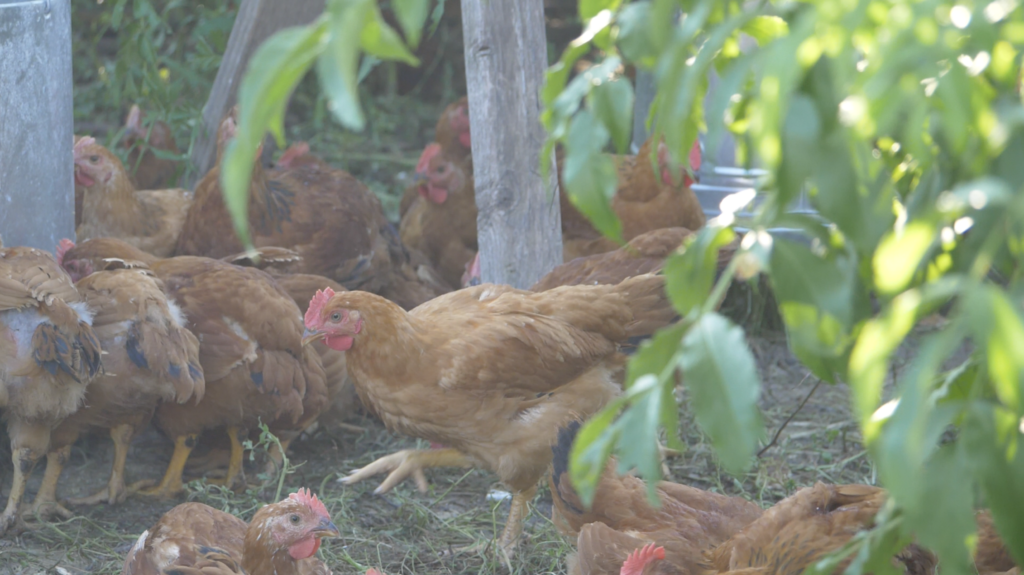
We’ve done a good job of this with cattle and with pigs. In this interview, though, Reginaldo Haslett-Marroquin asks whether we’ve really done the same with chickens.
Reginaldo farms at Salvatierra Farms and is the founder of the Regenerative Agriculture Alliance and co-founder of Regenerative Agriculture Solutions. He is the author of In the Shadow of Green Man: My Journey from Poverty and Hunger to Food Security and Hope.
Acres U.S.A.: What is a tree range chicken?
Reginaldo Haslett-Marroquin: “Tree-range” is a brand. We call the system “poultry-centered regenerative agriculture.”
The system — poultry-centered regenerative agriculture — is centered on returning poultry to its natural evolutionary habitat. Chickens are jungle fowl. So that’s the departing point, and from that departing point, we have engineered all the necessary agronomic details to codify the process by which you take any ecological blueprint on the planet and you restructure it to become the closest modern expression of the chicken’s ancestral habitat.
So, if we are in northern Guatemala, we’re going to use forest species from the rainforest in the understory and overstory. We’re going to use different agronomics there, different tactics for food sources, and so on. If you go out to the islands, we adapt to that. In Minnesota we use hazelnuts and elderberries as the understory, and whatever wood species are native to the original ecology we’re working with as overstory.
The key is to provide the chicken with that ancestral habitat. It’s only possible to optimize the welfare of the animal by restoring and optimizing the natural and essential habitat — because they evolved in that space.
Now, a model of production on a farm is not a system. The system is actually a multi-layered infrastructure, both physical and non-physical. The physical infrastructure includes processing facilities, transportation, aggregation and distribution centers, freezing, branding, marketing, and grain production. The non-physical infrastructure — the support infrastructure — includes all of the families of businesses that evolve to take the production model and scale it for the purpose of building a supply chain that is regenerative as a system, rather than just as a farm.
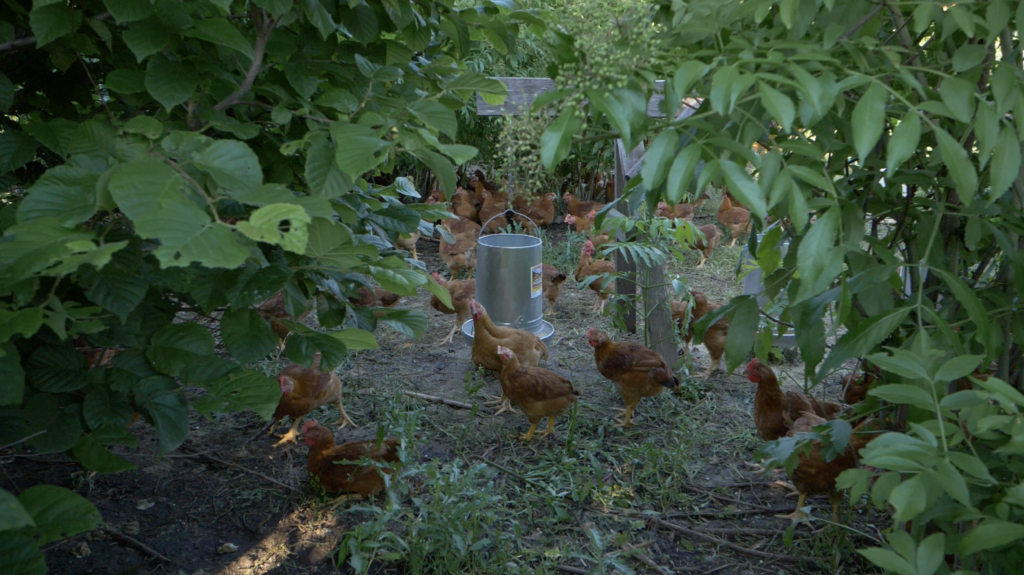
Acres U.S.A.: People have picked up on this point with pigs — that pasture is not necessarily the eco-system that best fits pigs’ innate abilities or desires — and so they’re moving toward forest raised. But you don’t hear many people talking about that with chickens — “pasture raised” is still the popular phrase.
Haslett-Marroquin: Chickens, turkey and pigs are all forest species. Chickens are more of a jungle species. Turkeys do venture into the savanna openings. They don’t nest in the woods — they nest in the savanna, in the grasses.
We had some significant challenges in the beginning with our chickens because they didn’t want to lay eggs inside the buildings, in the nest boxes — because we had restored their habitat to such a level that it was perfect for them to make their nests and lay eggs outdoors. So, instead of forcing them to stay inside and forcing them into the nests, we studied the behavior of the egg layers and started to build an environment inside the building where they would find those characteristics. Egg layers literally have a checklist they go through to decide where they want to lay their eggs. If you figure that out, you can create exactly the conditions that the chicken is looking for — and then you don’t have to confine them. You still let them outside, but they will lay 95 percent of their eggs where you want them to — you don’t end up chasing chickens around.
Acres U.S.A.: What was the element they were missing?
Haslett-Marroquin: You literally get into the head of the chicken. The chicken makes a very specific noise — a very specific chant — when she’s going to lay an egg. She doesn’t cackle before she lays an egg — she cackles afterward. When you hear those noises, you identify those chickens, and then you follow them. And you look at what they’re looking at, and you try to see the world from their perspective. What you find is seclusion and darkness. How it is secluded has a lot to do with why they choose one secluded place versus another. They need to have a way to move away from where they lay their egg. They do it quietly. They never cackle right after they lay an egg, for example. You have to provide all of those characteristics and spaces.
The broilers are different, but fundamentally, both layers and broilers are junglefowl in the way they behave and range and eat. Chickens and turkeys evolved eating grains; cows and other grass-based animals didn’t — they evolved in grasses. The pig roots things and eats bugs and grubs and roots. It will forage, but just like with chicken, the foraging is not sufficient. They can’t get enough biomass to support their body functions.
The idea of a fast-food chicken is an oxymoron — there is no such thing. You can put them out into a pasture, but that doesn’t mean they’re going to eat grass. You end up creating an environment where they need a lot more ground-up feed, because they are using a lot more energy — not only running around, but also trying to digest a food that is foreign to their digestive tract. You literally end up with a chicken that takes in more feed because it’s outside.
It’s critical to understand all of these little details if we’re going to engineer a system that allows us to innovate. Putting a small flock on pasture and confining them in a space, even though you’re moving them every day — it’s still confinement.
Acres U.S.A.: How do you keep chickens where you want them in this model? Do they have free range to the entire orchard that you’ve planted?
Haslett-Marroquin: We rotate them through two paddocks. When we started, we built smaller buildings. At first we had 50-bird flocks; then we went to 100 and then to 500, to 1,000, to 1,500, and to 2,000. Then we went back down 100 at a time — from 2,000 to 1,900 to 1,800. With 2,000 birds in the flock, because of their ranging ability, everything started to break down — it was not working. We needed to find that sweet spot where we had the right number of birds for the system.
We started with four paddocks, but that was too complicated. Chickens are such homing animals — they want to go back to the same spot where they slept and ate the day before. It’s really hard to move them. When they are free, they won’t move. If you asked a chicken, “Do you want to be moved,” they would say, “Absolutely not!” To move them, you have to cage them.
So we started with four paddocks surrounding one building. But the health of the animals deteriorated as the density increased. We started to figure out that we needed a lot more space outside. The objective was to get the chickens on fresh forage on a regular basis. So we moved to three paddocks, but it wasn’t just about the chicken — it’s also about us and the amount of work we have to do: the amount of handling, the amount of fences we had to put up, the amount of doors in the barn — and the potential of one of those failing and predators getting in.
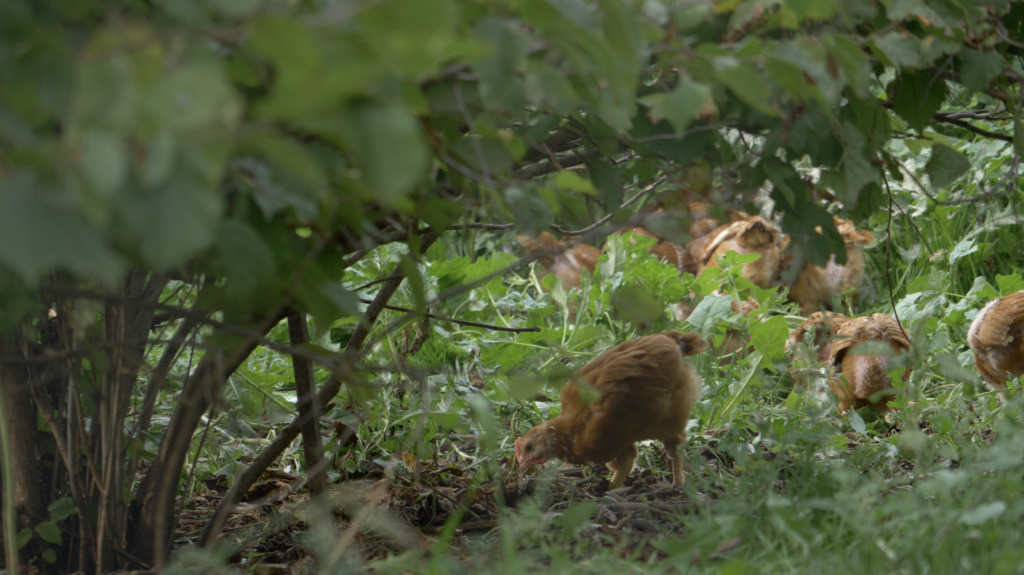
Bottom line, we ended up with two rotational paddocks. We put them on one side for a certain number of days — which is not determined by us, but rather by the condition of the space. It’s an observation-based method; we observe when they have ranged all the corners of that paddock. At the same time, we are planting and regenerating the other paddock.
We feed them their natural foods — sprouted rain, primarily, and forages — but focusing not on the pasture concept, but rather high-protein, low-fiber plants. These are plants that they have taught us they want. I spent two years observing what they pick first, second, third, etc. They never touch the grasses — they always trample them, although they do eat them if they are tiny and tender. But they definitely always go for the sprouts we provide. The sprouting system requires certain conditions as well.
The canopy is a multi-purpose infrastructure that we put in each paddock so that we can rotate the chickens back and forth while managing this relatively extensive set of practices at the ground level — the organic matter, the biology; even the worm population is critical at that level. We tested multiple levels of density for the canopy, because the density of canopy allows the chickens to be more relaxed and to range farther away from the building. We evaluated how far they would range so we knew where to put the fences — we were not arbitrarily deciding what the ranging space of the chicken was. It’s not homocentric, but rather chicken centered.
Once we did all of that, then we developed the specifications that give us the production unit that we are deploying over and over and over. That’s how the system works.
Acres U.S.A.: What’s the rotation time? It’s obviously dependent on many factors, but ballpark — are we talking a week? A month? Three months?
Haslett-Marroquin: It’s definitely days. A week is probably as much as we want to keep a flock in a single paddock. Maybe a week and a half if you are in a dry region, for example. In dry regions, we are installing these units with irrigation so that we can actually sprout grain whether it’s dry or not. Even here in Minnesota, we’re installing irrigation, because we are intensifying the system — we’re not just raising a couple hundred chickens in a single paddock. We want to optimize the regrowing capacity of that space. We want to keep that space always covered. In a dry region, they’re going to eat the forage a lot faster than in a region like Minnesota, so the rotational schedule in the dry region is going to be different. Right now, in South Dakota, where the desert is actually encroaching north, from the south and the southwest, we’re starting to think about designing the units differently, with climate change in mind, so we don’t have to modify them five or 10 years from now.
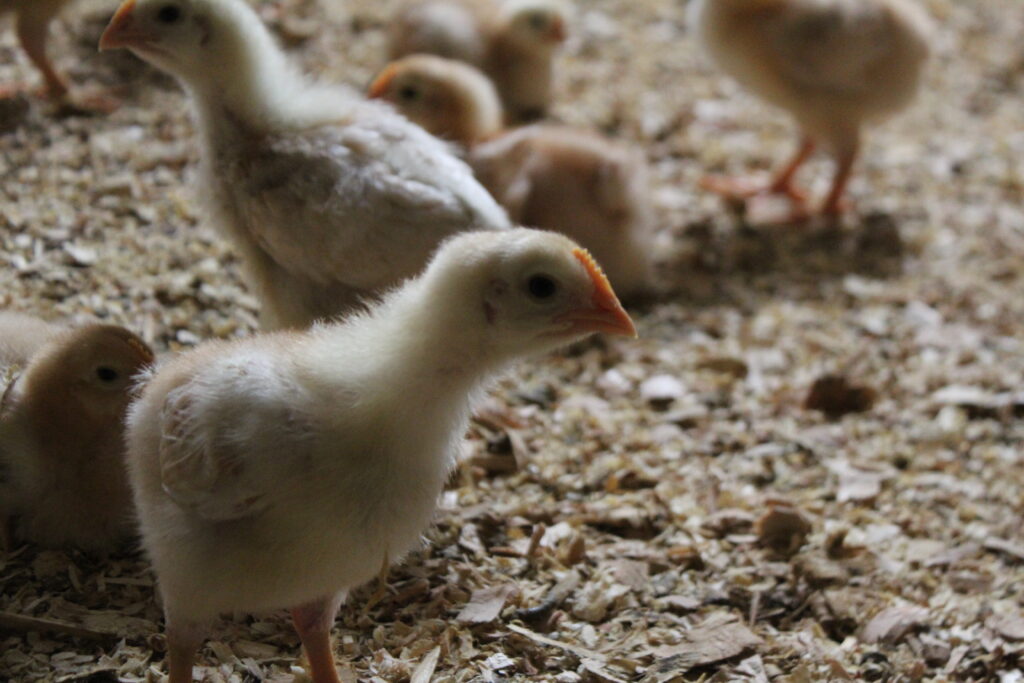
Water is the centerpiece of how we rotate. Without water, we would have to reduce flock size significantly so the birds don’t obliterate the cover too soon. The idea is that they stay on one paddock long enough for the other one to regenerate. We have to keep the ground covered, but 2-3-4 rotations is all we need before they are ready to be shipped to the processor.
Acres U.S.A.: So that’s for your broilers; how is it different for layers?
Haslett-Marroquin: The layer uses a whole different footprint. Broilers here in Minnesota get 40 square feet per chicken. For 15 years now that’s worked beautifully. In South Dakota we had to modify that. The farmers there didn’t want larger flocks — 1,500-bird flocks — they wanted to start with flocks of only 600 birds. So, with them, we’re actually doing multiple-sized units and increasing the ranging space by 25 percent.
For egg layers, we started with twice the square footage that we use for broilers — the same two paddocks, but twice as much space. Again, that’s in Minnesota, and keep in mind that the egg layer is different from the broiler; the broiler is going to be an adult in that pattern for about a week. That’s it — then you send them over to the processor.
If you have a brooder and you start the next flock inside the brooder for those first three weeks, you’re bringing in three-week-old chickens and they’re still going to go another week inside the barn. And then on the fourth week they’re going to come out, but they’re going to be small, with very low impact on the land. That doesn’t happen with egg layers. The egg layer is an adult for 80 weeks in that same space. So everything, from the feed to the sprouting system to the forages — the hens don’t even forage as aggressively as the broilers do. We had to start thinking about what forage species they do better with. They’re totally different animals.

Acres U.S.A.: What is that in terms of total acreage that you would need for this model, for someone starting out?
Haslett-Marroquin: It’s one and a half acres. You divide that into two paddocks, and in the center you put the barn, and then you put in your feed bin and you install your automated watering system. And then you plant hazelnuts — 12 feet apart in the row and eight feet between rows, if you use the varieties we use. Or elderberries — you just plant the rows 12 feet apart. The rows will close themselves in, and then you keep the middle — the valleys — mowed so that you always have that open space for the chickens to run, if they want.
That lets the canopy cover the ground at least 60 percent. We evaluated the behavior and the stress levels of chickens below 60 percent canopy and found that they get really stressed out. We put cameras on the ground, and we flew a drone overhead. We started with 100 percent canopy — no sunlight. We had planted those mammoth sunflowers that grow really high, to resemble the canopy we were looking for. In that 100 percent canopy, the chickens didn’t even notice the drone. And they react the same way to the drone as they do to a hawk. So that was a very easy, replicable methodology for us.
Then I went in with a machete and thinned it out and then measured the ground to make sure that sunlight was coming in at a certain percentage. We did multiple samples at different canopy percentages. By the time we reached 60 percent, the chickens would notice the drone and would run quickly under the sunflowers. They stayed there for just a few seconds, and then they forgot what was wrong and started moving again. Below 60 percent, you could see them get agitated, and they stayed under the canopy longer. And you could see the stress in their behavior. They make certain kinds of noises when they are stressed — especially the males. We listened for those noises because they’re like an alert system. They freeze in place and identify the object, and if they see it as a threat, they dash for the trees. If it isn’t a threat, they make another noise and keep going. Our goal was to ensure that we were optimizing the animal welfare as a foundation of the system.

Acres U.S.A.: So you use the same 60 percent canopy for both broilers and layers?
Haslett-Marroquin: Yes. They behave the same way. Now, the layers are way more astute because they’re there longer and learn their environment. It was very easy to see which trees they went under — what they preferred.
And then we move on to other pieces of the system. We keep codifying different things based on observing where the chicken goes, what he prefers — how he’s actually behaving like a chicken, versus us forcing him to do something. That’s what we call the indigenous process, where you look at the process not from the homocentric perspective, but rather — to the extent that you can indigenize your mind to this space — you look at it from the animal’s perspective, or even from the perspective of the tree.
For example, when we started looking at the space from the hazelnut’s point of view, we realized that the hazelnut evolved to capture nitrogen over the surface of the soil. It heavily feeds on the surface. It wants to attract nitrogen from the birds because it’s a heavy nitrogen feeder. It wants to attract fowl to its trunk, and it does that by creating a solid, 100 percent canopy. When the chicken seeks shelter, it wants 100 percent protection — not 60. But it will roam around at 60 percent.
We really geeked out on this to come up with a good system.
Acres U.S.A.: You did a ton of research and observation to make this happen. How do you recreate 60 percent canopy in years zero through three or four — before you have a canopy from the hazelnuts and elderberries?
Haslett-Marroquin: We’ve succeeded in doing that with rotations of sunflowers one year and corn the next — both of which we harvest for chicken feed.
And if you do both elderberries and hazelnuts, just make sure that the rows are not mixed. That makes for much easier harvesting. The symbiotic relationship between the hazelnut and the elderberry is going to happen anyway, because they still interlock roots underground, beneath the rows.
Acres U.S.A.: How do you deal with competition from weeds and grass in the hazelnuts and elderberries in years one or two?
Haslett-Marroquin: The beauty of broilers especially is that they obliterate everything. They eat everything, or they at least trample the grasses down. If you follow our protocols, you will get every corner of that paddock foraged, and they do control 100 percent of the weeds — if you are consistent with the chicken presence. If you go without a flock for a month, those weeds take off even wilder. That’s when we have to mow. We hate mowing, because that’s just energy we pay to mow down feed, which could be foraged and turned into meat that we could market.
Acres U.S.A.: What grains are you feeding? And can you talk about your process of sprouting it?
Haslett-Marroquin: We feed them certified-organic ground-up feed in the feeders. And we plant certain medicinal herbs and some forages and some weeds — like mallow and purslane, which are highly nutritious and grow for free. Mallow is this really nice because the chickens only eat the leaves; they don’t eat the stems. As soon as you move the birds, the mallow comes back really strong and grows highly nutritious, dense forages for them.
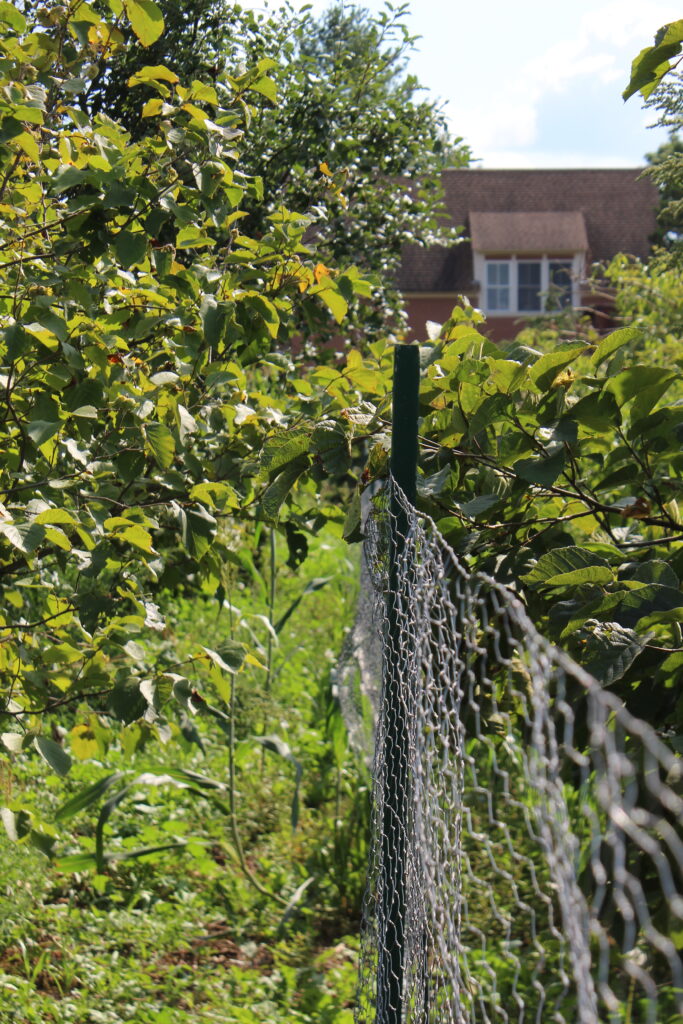
Beyond that, we have sprouted grain. The way we sprout is by just putting the whole grain on a regular grain spreader — the one we use fits about 200 pounds. Sometimes we do a single grain; sometimes we do multiple. We have done all the way up to seven grains, depending on what we have available and what the local grain production ecosystem can deliver. It has to be viable — if you’re going to use corn, it’s better to have corn that was not mechanically dried, because then the germ would have been killed and won’t germinate anymore, because it’s literally cooked. You can’t use soybeans because they are toxic.
But we use almost every other seed, from sunflowers and buckwheat to wheat and oats. You have to be careful with buckwheat, because the chickens only eat it until it’s fully sprouted. They prefer the other seeds as sprouts. We want the chicken to eat the sprout right as the future grass blade is still white. So, we put the grain in the spreader, and we go up and down the alleys with the tractor. It takes 15-20 minutes to spread a couple thousand pounds.
Acres U.S.A.: And this is a supplement to their dry feed and their forage.
Haslett-Marroquin: Yes, but in some cases — at least three flocks now — we have removed the ground-up feed completely for up to 17 days for the broilers. This is unheard of. Try doing that at home — it’s not going to work. After half a day the birds will be going crazy. But we’re pushing those limits, because feed is 60-plus percent of the cost of a dozen eggs or a pound of meat. That’s where we have the largest opportunity for innovation.
But you can’t innovate if you don’t have a system where the chicken is in its natural habitat. The only place you can do this is in the natural ecosystem of a chicken. You can’t do this in confinement. You could sprout the grain artificially, but at that point, just grind it and feed it to them — there’s no aggregate benefit that is going to be less costly. If you’ve got mobile confinement facilities, where you’re putting a lot of chickens in a mobile thing that you move down a field, same thing — there is no food there for them. You can’t put the sprouts ahead of the moving unit, because the birds will defecate all over it within the first hour, and then it will be contaminated, and they’ll be eating their own manure. This doesn’t work unless you have a system like ours.
That’s why we never went in the movable tractor direction. We wanted to do this at scale — all of it, not just the chickens. We wanted to disconnect — unplug — ourselves from being slave to the ground-up feed supply. And we have achieved that, to a great extent.
Acres U.S.A.: For the broilers, are you using some type of freedom ranger?

Haslett-Marroquin: The bottom line for us is the characteristics of the breed. For that we’re looking at the Global Animal Partnership classification of breeds. The key is that they need to range really well. They need to be slow growth. The faster they grow, the less they range and the more hungry they are — and the less they’re going to defend themselves and be alert to predators. It’s just too many complications.
Seventy days is the minimum for us. If we can find a marketable broiler that takes longer, that gives us a much larger advantage. Because the longer the bird takes to grow, the more we can diversify its food source and lower the feed cost. The faster it grows, the more the cost actually skyrockets because you are completely a slave to the ground-up feed supply. And that is always more expensive, no matter what.
Acres U.S.A.: You mentioned that there’s also a primary canopy — oak, or whatever is native in the region. Are you planting something that will ultimately be up above the hazelnuts and the elderberries?
Haslett-Marroquin: Yes, we’re looking at that. Elderberries and hazelnuts are both understory species, so they will do well under partial shade. That allows us to put in an overstory, which can be valuable timber products, or other species like sugar maple. Plus, we can take advantage of harvesting the elderberries and the hazelnuts.
The overall goal is superb health for the birds. We evaluate this with a single indicator: we look at mortality as the critical indicator of whether the welfare of the animal has been taken care of. We shoot for less than 4 percent mortality in any flock, and sometimes we have achieved 1.5 or 2 percent mortality, which is unheard of. I mean, everybody’s going to lose 10 to 15 percent of their chickens; we completely knock that out.
We also look at feather cover — if their chest is fully feathered — and the cleanness of the shanks — how solid they are. We watch them running out into the fields in the morning in order to evaluate their joint health. We know we are exceeding any animal welfare standards out there.
Acres U.S.A.: Harvesting is difficult for hazelnuts and elderberries; has that part of the operation been profitable? How much are those products adding to the bottom line?
Haslett-Marroquin: Yes, we harvest by hand — that’s just the way it is. I don’t think of it as good or bad, efficient or inefficient.
Last year, because the chickens are weeding and fertilizing, the hazelnut and the elderberry inside our chicken paddocks totally outperformed the hazelnuts and elderberries we have outside of the chicken areas — even though we do move the poultry manure from the barns into the hazelnut and elderberry areas where there are no chickens. We are expanding our hazelnut and elderberry industry so that we can eventually justify mechanization — investing in equipment to mechanize harvest. We’re building the first regenerative agriculture industrial park, probably, in the country. This industrial park is going to be designed as a mirror of the landscape layout. There’ll be chicken processing, hazelnut processing, elderberry processing, and potentially banking services and all those sorts of things associated with the system. At that point, we will totally change the way we handle hazelnuts and elderberries.
But they are a significant crop. Last year, the income from the hazelnuts in the same unit where I grew the chickens was identical to the net income from the chickens.
Acres U.S.A.: Can you talk about how you process the birds?
Haslett-Marroquin: We bought our own processor. We collectively bought a processing facility in Statesville, Iowa, and we schedule our own flocks in our own processor. We own all of that.
Right now we’ve got so much excess capacity that we process for other farmers. But we are the priority. If we grow 100 percent of the chickens the plant can process, then that’s for us, not someone else.
At the system organizing level, there are other indicators of regeneration. For example, an individual farm cannot be regenerative — period. It just can’t build the ecosystem necessary to regenerate. We’re looking at regeneration not from the perspective of a chicken or a farm or a production unit. For us, regenerative poultry is about the system — everything from grain production, poultry production, poultry processing, transportation, marketing, branding, distribution, to, in some cases, agronomics and cultural practices. Sometimes you are looking at ownership and control. Other times, wealth distribution. All of these are part of the regenerative standard of poultry. It’s not just raising chicken.
Acres U.S.A.: How many farms do you have operating this system right now?
Haslett-Marroquin: We’re in Minnesota, Wisconsin and Iowa, where we have the first processor. We also work with another operation we help set up in Pine Ridge, which has another processor and their own networks of farms. We’re setting up another operation in Nebraska now, with the same idea.
Right now, in total, we have 11 farms producing chickens with another 10 coming in next year. We have 15 farms producing grains, and we just launched our grain cleaning and processing facility as well. We are aggregating 14 enterprise sectors that form the regenerative poultry system.















